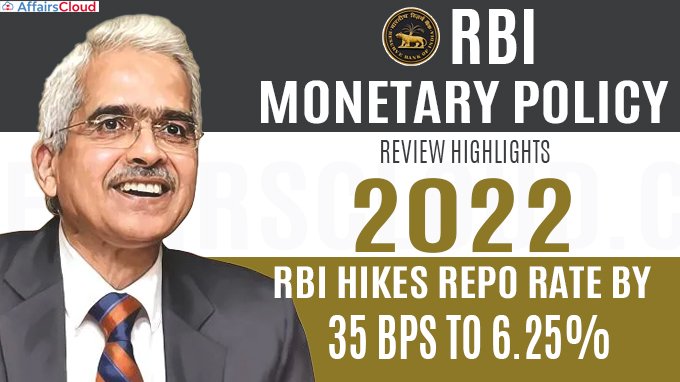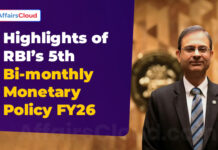 The Reserve Bank of India’s (RBI) Monetary Policy Committee (MPC) met on December 5-7, 2022 , and released the Monetary Policy Statement, 2022-23 Resolution of the MPC which declined India’s real Gross Domestic Product (GDP) growth to 6.8% for FY23 from 7% (projected in September 2022) with FY23’s Q3 at 4.4%; and Q4 at 4.2%.
The Reserve Bank of India’s (RBI) Monetary Policy Committee (MPC) met on December 5-7, 2022 , and released the Monetary Policy Statement, 2022-23 Resolution of the MPC which declined India’s real Gross Domestic Product (GDP) growth to 6.8% for FY23 from 7% (projected in September 2022) with FY23’s Q3 at 4.4%; and Q4 at 4.2%.
- The stance is to focus on withdrawal of accommodation.
- Real GDP growth for Q1FY24 is projected at 7.1% and at 5.9% for Q2.
Inflation:
i.Inflation is projected at 6.7% in FY23, with Q3 at 6.6% and Q4 at 5.9%, and risks evenly balanced.
ii.CPI inflation for Q1FY24 is projected at 5% and for Q2 at 5.4%, on the assumption of a normal monsoon.
iii.Headline inflation is expected to remain above or close to the upper threshold in Q3FY23 and Q4FY23.
- It is likely to moderate in H1FY24 but will still remain well above the target.
RBI’s Policy Rates:
The MPC raised the repo rate by 35 basis points to 6.25% from 5.90%. Consequently, the Standing Deposit Facility (SDF) Rate adjusted to 6% and Marginal Standing Facility (MSF) rate and Bank Rate to 6.50%.
Click here for previous policy rates which revised in September 2022.
| Category | Rate |
|---|---|
| Policy Repo Rate | 6.25% |
| Reverse Repo Rate | 3.35% |
| Standing Deposit Facility (SDF) Rate | 6% |
| Marginal Standing Facility (MSF) Rate | 6.50% |
| Bank Rate | 6.50% |
| Cash Reserve Ratio (CRR) | 4.50% |
| Statutory Liquidity Ratio (SLR) | 18% |
Domestic Economy:
i.India’s real GDP grew by 6.3% year-on-year (y-o-y) in Q2FY23 after an increase of 13.5% in Q1.
ii.In October 2022, CPI (Consumer Price Index) inflation moderated to 6.8% y-o-y from 7.4% in September 2022.
- Core CPI (i.e., CPI excluding food and fuel) inflation persisted at elevated levels at 6%.
iii.The overall liquidity remains in surplus, with average daily absorption under the Liquidity Adjustment Facility(LAF) at Rs 1.4 lakh crore during October-November 2022 as compared with Rs 2.2 lakh crore in August-September 2022.
iv.As on November 18, 2022, on a y-o-y basis, money supply (M3) expanded by 8.9% while bank credit rose by 17.2%.
v.As on December 2, 2022, India’s foreign exchange reserves were placed at US$ 561.2 billion.
vi.Net Foreign Direct Investment (FDI) flows rose to US $ 22.7 billion during April-October 2022 from US$ 21.3 billion in April-October 2021.
vii.During April-November 2022, non-food bank credit rose by Rs 10.6 lakh crore as compared with an increase of Rs 1.9 lakh crore in 2021.
viii.During April-November 2022, the total flow of resources to the commercial sector expanded by Rs 14.7 lakh crore as compared with Rs 6.8 lakh crore in April-November 2021.
ix.Merchandise imports expanded by 10% in October 2022.
x.The agricultural sector remains resilient.
- As on December 2, 2022, the Rabi sowing area is 6.8% higher than the normal sown area
xi.The manufacturing PMI (Purchasing Managers’ Index) rose from 55.3 in October 2022 to 55.7 in November 2022. The PMI for the services sector also expanded from 55.1 in October 2022 to 56.4 in November 2022.
- Notably, the manufacturing and services PMIs for India in November 2022are among the highest in the world.
Other Measures:
RBI extended the dispensation of enhanced HTM limit of 23% to March 31, 2024
MPC extended the dispensation of enhanced Held to Maturity (HTM) limit of 23% of deposits in respect of statutory liquidity ratio (SLR) securities up to March 31, 2024 in order to provide further flexibility to banks in managing their investment portfolios,
Key Points:
i.This will enable banks to include SLR securities (Government Securities and State Development Loans) acquired between September 1, 2020 and March 31, 2024 in the enhanced HTM limit.
ii.The HTM limits would be restored from 23% to 19.5% in a phased manner starting from the quarter ending June 30, 2024.
iii.HTM securities are debt securities that companies purchase with the intent to keep them until maturity.
Background:
RBI had increased the limits under the HTM category from 19.5% to 23% of net demand and time liabilities (NDTL) in respect of SLR eligible securities acquired on or after September 1, 2020, up to March 31, 2023.
RBI introduced single-block-and-multiple-debits functionality in UPI
RBI has enhanced the scope of Unified Payments Interface (UPI) by equipping it with single-block-and-multiple-debits functionality. It will be introduced by National Payments Corporation of India (NPCI).
- This facility will enable a customer to create a payment mandate against a merchant by blocking funds in his/her bank account for specific purposes which can be debited, whenever needed.
- UPI is a popular retail payments system for Person to Person (P2P) and Person to Merchant (P2M) transactions.
RBI has decided to expand the scope of BBPS
RBI also extended the scope of Bharat Bill Payment System (BBPS) by including all categories of payments and collections, both recurring and non-recurring, and for all category of billers (businesses and individuals).
- This means now BBPs will also cater to bill payments or collections such as payment of fees for professional services, education fees, tax payments, rent collections, etc.
RBI allows resident entities to hedge gold price risks at IFSC
RBI has given its nod to Indian residents to hedge their exposure to gold on recognized exchanges in the International Financial Services Centre (IFSC).
Key Points:
i.Resident entities in India are currently not permitted to hedge their exposure to gold price risk in overseas markets.
ii.Now, this measure will benefit importers/exporters of gold such as jewellers and industries which use gold as an intermediate or raw material.
iii.The detailed instructions on the same will be issued separately by the central bank
Banks should not ask for verification at branch level if e-KYC done
RBI also mandates banks to not ask for verifications/updates at the branch level in case a customer has done e-KYC or those who have completed the KYC (know-your-customer) process on the central-KYC (C-KYC) portal.
Key Points:
i.Bank customers who’ve completed their KYC verifications online can do the annual updates or changes, if any, in their personal details online.
ii.Customers who have uploaded their KYC details on the C-KYC portal should not be asked for verification by any bank.
- In such cases, the customer can just mail or message from the registered email ID or mobile to the bank to access the KYC details from the C-KYC portal.
RBI restores market trading hours to pre-pandemic timing
RBI has restored the pre-pandemic trading hours for some segments of money markets and rupee interest rate derivatives w.e.f. December 12, 2022 which are as follows:
- The timing for Call/notice/term money market, Commercial paper and Certificates of Deposit, Repo in Corporate Bonds, and Rupee Interest Rate Derivatives will be 9:00 AM to 5:00 PM
- The timing for Government Securities (Central Government Securities, State Development Loans and Treasury Bills), Foreign Currency (FCY)/Indian Rupee (INR) Trades including Forex Derivatives will be 9:00 AM to 3:30 PM
- The timing for Market repo in government securities is Market repo in government securities.
- The timing for Tri-party repo in government securities is 9:00 AM to 3:00 PM.
Background:
RBI had during the pandemic reduced the market trading hours with effect from April 7, 2020, in view of the operational dislocations and elevated levels of health risks posed by the COVID-19 pandemic.
The next meeting of the MPC is scheduled during February 6-8, 2023.
Members of MPC:
Dr. Shashanka Bhide; Dr. Ashima Goyal; Prof. Jayanth R. Varma; Dr. Rajiv Ranjan; Dr. Michael Debabrata Patra; and headed by Shaktikanta Das (RBI Governor).
About Reserve Bank of India (RBI):
i.The Reserve Bank of India was established on April 1, 1935, in accordance with the provisions of the Reserve Bank of India Act, 1934.
ii.The Central Office of the Reserve Bank was initially established in Calcutta but was permanently moved to Mumbai in 1937.
iii.Though originally privately owned, since nationalization in 1949, the Reserve Bank is fully owned by the Government of India.




